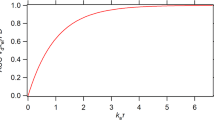Abstract
The highest point of the plasma concentration-time profile, C max , is currently used by regulatory agencies to assess the rate of drug absorption after single dose administration of oral products. It is, however, quite insensitive, and a number of new measures of rate have been proposed. Using simulations, several approaches toward measuring rate were tested. A set of model scenarios for drugs with typical mean characteristics and statistical distributions was investigated. Using different kinetic models of disposition, the time course of the concentration in plasma was simulated. Intraindividual and interindividual variability and assay error were modeled using Monte Carlo techniques. The accuracy, precision, and ease of use of the various measures of rate were evaluated by simulating crossover design clinical trials and then determining the probability of declaring bioequivalence as a function of differences in rates of absorption between test and reference formulations. All of the rate measures tested showed a degree of insensitivity to changes in rate and no universally superior measure was found. Indeed, the main conclusion is that the choice of a measure should be based on simulations of the particular situation in a bioequivalence trials.
Similar content being viewed by others
REFERENCES
F. Y. Bois, T. N. Tozer, W. W. Hauck, M.-L. Chen, R. Patnaik, and R. L. Williams. Bioequivalence: performance of several measures of extent of absorption. Pharm. Res. (in press).
W. W. Hauck and S. Anderson. Types of bioequivalence and related statistical considerations. Int. J. Clin. Pharmacol. Ther. Toxicol. 30:181–187 (1992).
M. L. Chen. An alternative approach for assessment of rate of absorption in bioequivalence studies. Pharm. Res. 9:1380–1385 (1992).
L. Endrenyi, S. Fritsch, and W. Yan. Cmax/AUC is a clearer measure than Cmax for absorption rates in investigations of bioequivalence. Int. J. Clin. Pharmacol. Ther. Toxicol. 29:394–399 (1991).
M. Rowland and T. N. Tozer. Clinical Pharmacokinetics: Concepts and Applications, Lea & Febiger, Philadelphia, 1989.
A. Racine-Poon and A. F. Smith. Population models. In D. A. Berry (ed.), Statistical Methodology in the Pharmaceutical Sciences, Marcel Dekker, Inc., New York, 1990, pp. 139–162.
D. J. Schuirmann. A comparison of the two one-sided tests procedure and the power approach for assessing the equivalence of average bioavailability. J. Pharmacokin. Biopharm. 15:657–680 (1987).
Food and Drug Administration—Office of Generic Drugs—Division of Bioequivalence. Guidance on statistical procedures for bioequivalence studies using a standard two-treatment crossover design. 1992.
Drug Information Association Working Group. International harmonization and consensus DIA meeting on bioavailability and bioequivalence requirements and standards. Drug Info. J. 25:471–482 (1991).
L. B. Sheiner. Bioequivalence revisited. Statistics in Medicine 11:1777–1788 (1992).
A. Rescigno. Bioequivalence. Pharmaceutical Research 9:925–928 (1992).
Author information
Authors and Affiliations
Rights and permissions
About this article
Cite this article
Bois, F.Y., Tozer, T.N., Hauck, W.W. et al. Bioequivalence: Performance of Several Measures of Rate of Absorption. Pharm Res 11, 966–974 (1994). https://doi.org/10.1023/A:1018970901116
Issue Date:
DOI: https://doi.org/10.1023/A:1018970901116




